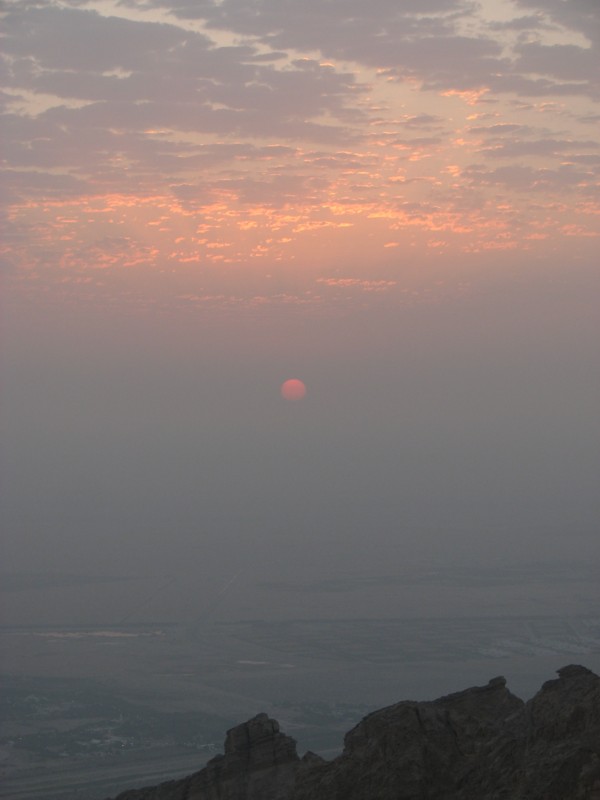
When to Observe Jumadal Awwal Waning (OLD) Crescent ?
The geocentric conjunction (Geocentric New Moon) will occur Inshalla on (Friday 15 June 2007) at
03:13 UT.
Sighting the OLD crescent on (Thursday 14 June 2007) is shown in the below graph using the program Accurate Times by Mohammad Odeh according to Odeh criterion. Where:-
- It is impossible to see the OLD crescent from the areas located under the red color. Because either the Moon on this day rises after the Sunrise and/or the topocentric conjunction occurs before the Sunrise.
- The crescent is expected to be seen by optical aid only from the areas located under the blue color.
- The crescent is expected to be seen by optical aid from the areas located under the magenta color. In these areas the crescent could be seen by naked eye if the atmospheric conditions are superb and the observer is experienced.
- The crescent is expected to be easily visible by naked eye from the areas located under the green color.
- The crescent can not be seen from uncolored areas, even though the Moon rises in these locations before the Sunrise and the topocentric conjunction occurs after the Sunrise, but the Moon is not sufficiently illuminated in order to be seen as crescent even by optical aid.
- Kindly notice that the below graph shows the possibility of seeing the crescent from areas between 60 degrees north of Equator down to 60 degrees south of Equator.
Thursday 14 June 2007


Jumadal Awwal Waning (OLD) Crescent Observation Results
Thursday 14 June 2007:
- Indonesia: Seen: ICOP member Mr. Ma'rufin Sudibyo said: "The waning crescent observation was done in Kebumen (7deg 40min South, 109deg 38min East, 21 m above mean sea level, time zone = GMT + 7), Indonesia, at June 14th 2007. Our observation placed on Kebumen Islamic Center because this place has good view to eastern sky. The Wonokromo and Bulupitu Hills, which part of Kedungbener fault, evident in eastern horizon, while the crescent (and Sun too) estimated arises from Wonokromo Hill that has altitude 3 degrees, approximately. So the crescent will visible if it has altitude more than 3 degrees, technically. We used naked eye and helped by internal clock Siemens C45 cellular phone as time guidance that calibrated with 103 dials served by Telkom Co. Ltd. We also used the Moon altitude vs. local time table, which derived from MoonCalc v4.0 at topocentric, no refraction and sunrise/sunset geometric condition. Based on MoonCalc v4.0, at sunrise time the Moon has elements: altitude 14,38 degree, azimuth 59,95 degree (relative azimuth -6,63 toward Sun), elongation 15,97 degree, visual magnitude -5,66, phase 2,2 %, Moon age -28,3 hour (before conjunction) and crescent width is 0,6 arc minutes. Because eastern sky almost cloudy by cumulus clouds when we started our observation, the crescent was seen only from 05:05 until 05:09 local time when part of sky above Wonokromo Hill was clearer. Then, the cumulus clouds moved to North and cover up it. Because the crescent was blurred by thin-moderate clouds on foreground, we cannot identified the crescent "horn" and its orientation. The crescent was seen as point-light source like a bright star. But at that time, based on Starry Night Backyard v3.1 star map and Steve Moshier's Ephemeris Program v5.6, the nearest bright star was alpha Tauri (Aldebaran) and it has very low altitude and hidden by Wonokromo Hill."
- Iran:
- Seen: ICOP member Mr. Alireza Mehrani mentioned that he was able to see the crescent by naked eye.
- Seen: ICOP member Mr. Majid Marzani said: "The crescent was seen by naked eyes from Behind high buildings in Tehran."
- Seen: ICOP member Mr. Mohammad Zahed Aram mentioned that he was able to see the crescent by naked eye.

Waning Crescent from Iran on Thursday 14 June 2007.
- USA: Not Seen: ICOP member Mr. Jim Stamm said:
Location = Tucson, Arizona (USA)
Longitude = 110.9645 W
Latitude = 32.4204 N
Elevation = 842 meters
Time Zone = -7.0 hours
Surface conditions at Tucson International Airport (805 m):
Temperature = 22 degrees Celcius
Relative Humidity = 23 percent
Atmospheric Pressure = 1009 mb
Magnitude limit at 6 degrees altitutde with 55 power in C-8 telescope, before onset of twilight = 10
Topocentric and local time values from “Accurate Times”:
Moonrise (at sea level) = 04:21
Sunrise (at sea level) = 05:11
Time from new moon at 05:08 = 16 hr. 13 min.
Moon lag time = 50 minutes
Relative Altitude = 8.8 degrees
Elongation from sun = 9.1 degrees
Crescent width = 12 arcseconds
Illumination = 0.6 percent
I was NOT able to see the crescent, even through a telescope. There were just enough thin clouds near the horizon to make the sky yellow.
















